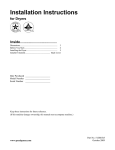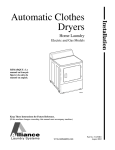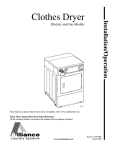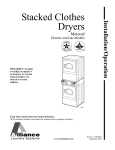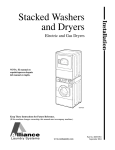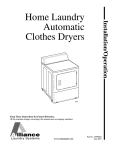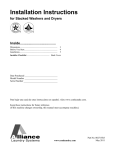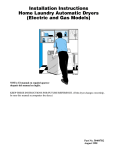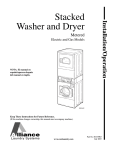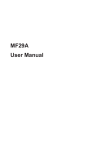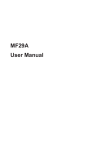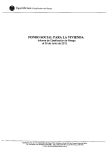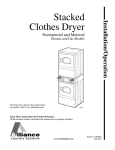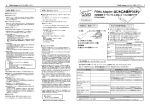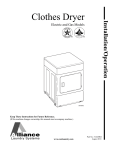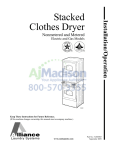Download Alliance Laundry Systems D715I User's Manual
Transcript
Installation Automatic Clothes Dryers Electric and Gas Models D715I Para bajar una copia de estas instrucciones en español, visite www.comlaundry.com. Keep These Instructions for Future Reference. (If this machine changes ownership, this manual must accompany machine.) www.comlaundry.com Part No. 510963R5 June 2007 WARNING FOR YOUR SAFETY, the information in this manual must be followed to minimize the risk of fire or explosion or to prevent property damage, personal injury or death. W033 • Do not store or use gasoline or other flammable vapors and liquids in the vicinity of this or any other appliance. • WHAT TO DO IF YOU SMELL GAS: – Do not try to light any appliance. – Do not touch any electrical switch; do not use any phone in your building. – Clear the room, building or area of all occupants. – Immediately call your gas supplier from a neighbor’s phone. Follow the gas supplier’s instructions. – If you cannot reach your gas supplier, call the fire department. • Installation and service must be performed by a qualified installer, service agency or the gas supplier. W052 The following information applies to the state of Massachusetts, USA. ● This appliance can only be installed by a Massachusetts licensed plumber or gas fitter. ● This appliance must be installed with a 36 inch (91 cm) long flexible gas connector. ● A “T-Handle” type gas shut-off valve must be installed in the gas supply line to this appliance. ● This appliance must not be installed in a bedroom or bathroom. 510963 © Copyright, Alliance Laundry Systems LLC – DO NOT COPY or TRANSMIT 1 Notes 2 © Copyright, Alliance Laundry Systems LLC – DO NOT COPY or TRANSMIT 510963 Table of Contents Replacement Parts .............................................................................. 5 Installation........................................................................................... Dimensions and Specifications............................................................. Before You Start ................................................................................... Tools ................................................................................................ Exhaust............................................................................................. Electrical .......................................................................................... Gas ................................................................................................... Location ........................................................................................... Installing the Dryer ............................................................................... Step 1: Position and Level the Dryer ............................................... Step 2: Connect Dryer Exhaust System ........................................... Step 3: (Gas Dryer Only) Connect Gas Supply Pipe ....................... Step 4: (Electric Dryer Only) Connect Electrical Plug .................... Step 5: Wipe Out Inside of Dryer .................................................... Step 6: Plug In the Dryer ................................................................. Step 7: Check Installation ................................................................ Heat Source Check ............................................................................... Electric Dryers ................................................................................. Gas Dryers ....................................................................................... Reversing Door Procedure.................................................................... Manufactured (Mobile) Home Installation........................................... Electrical Requirements........................................................................ Electric Dryers ................................................................................. Gas Dryers ....................................................................................... Gas Requirements................................................................................. Location Requirements......................................................................... Dryer Exhaust Requirements................................................................ Exhaust System Materials................................................................ Make-Up Air Requirements............................................................. Exhaust System ................................................................................ Exhaust Direction............................................................................. Exhaust System Maintenance .......................................................... Dryer Airflow................................................................................... 7 7 8 8 8 8 8 8 9 9 9 10 11 12 13 13 14 14 14 15 16 17 17 21 23 25 26 26 26 27 27 28 28 Maintenance ........................................................................................ User-Maintenance Instructions............................................................. Lubrication ....................................................................................... Care of Your Dryer .......................................................................... Exhaust System ................................................................................ Information for Handy Reference......................................................... 29 29 29 29 29 30 Installer Checklist................................................................. Back Cover © Copyright 2007, Alliance Laundry Systems LLC All rights reserved. No part of the contents of this book may be reproduced or transmitted in any form or by any means without the expressed written consent of the publisher. 510963 © Copyright, Alliance Laundry Systems LLC – DO NOT COPY or TRANSMIT 3 Notes 4 © Copyright, Alliance Laundry Systems LLC – DO NOT COPY or TRANSMIT 510963 Replacement Parts If replacement parts are required, contact the source where you purchased your dryer, or contact: Alliance Laundry Systems LLC Shepard Street P.O. Box 990 Ripon, WI 54971-0990 Phone: (920) 748-3950 for the name and address of the nearest authorized parts distributor. 510963 © Copyright, Alliance Laundry Systems LLC – DO NOT COPY or TRANSMIT 5 Notes 6 © Copyright, Alliance Laundry Systems LLC – DO NOT COPY or TRANSMIT 510963 Installation Dimensions and Specifications 23.5 in. (59.7 cm) 28 in. (71.1 cm) 15.4 in. (39.1 cm) *43 in. (109.2 cm) 0.4 in. (1.1 cm) *15.44 in. (39.2 cm) *4.0 in. (10.2 cm) *4.5 in. (11.4 cm) *36 in. (91.4 cm) 8.0 in. (20.3 cm) *40.25 in. (102.24 cm) 22.38 in. (56.85 cm) 26.9 in. (68.3 cm) DRY2208N ELECTRIC DRYERS DRY2208N * With leveling legs turned into base. 23.5 in. (59.7 cm) 28 in. (71.1 cm) 26.9 in. (68.3 cm) 2.3 in. (6 cm) *15.44 in. (39.2 cm) 15.4 in. (39.1 cm) *43 in. (109.2 cm) 0.4 in. (1.1 cm) *4.0 in. (10.2 cm) *4.5 in. (11.4 cm) *36 in. (91.4 cm) 8.0 in. (20.3 cm) *40.25 in. (102.24 cm) 22.38 in. (56.85 cm) *2.8 in. (7 cm) DRY2209N 1 GAS DRYERS DRY2209N *With leveling legs turned into base. 1 510963 3/8 in. NPT Gas Connection © Copyright, Alliance Laundry Systems LLC – DO NOT COPY or TRANSMIT 7 Installation Before You Start NOTE: For more detailed information, refer to Section on Dryer Exhaust Requirements. Tools Electrical For most installations, the basic tools you will need are: ● ELECTRIC DRYER Dryer needs a 3 or 4 wire 120/240 or 120/208 Volt, 30 Amp, 60 Hertz, 1 phase electrical supply. ● GAS DRYER Dryer needs a 120 Volt, 15 Amp, 60 Hertz, polarized 3-slot effectively grounded receptacle. 2 1 3 NOTE: For more detailed information, refer to Section on Electrical Requirements. If the supply cord is damaged, it must be replaced by a special cord or assembly available from the manufacturer or its service agent and is to be replaced by a qualified service person. 5 4 Gas D818I 1 2 3 4 5 Wrench Screwdrivers Level Teflon Tape Duct Tape Dryer is equipped for Natural Gas with a 3/8 inch NPT gas supply connection. For more detailed information, refer to Section on Gas Requirements. Location Place the dryer on a solid floor with an adequate air supply. For more detailed information, refer to Section on Location Requirements. Figure 1 WARNING Exhaust Any disassembly requiring the use of tools must be performed by a suitably qualified service person. Use rigid metal duct and exhaust the dryer to the outside by the shortest route possible. W299 D314I Figure 2 8 © Copyright, Alliance Laundry Systems LLC – DO NOT COPY or TRANSMIT 510963 Installation Installing the Dryer ● DO NOT use plastic or thin foil ducting. ● Locate dryer so exhaust duct is as short as possible. For further assistance refer to Section on Location Requirements. ● Be certain old ducts are cleaned before installing your new dryer. Install dryer before washer. This allows room for attaching exhaust duct. ● Use 4 inch (102 mm) diameter rigid or flexible metal duct. Place the dryer in position, and adjust the legs until the dryer is level from side to side and front to back. ● The male end of each section of duct must point away from the dryer. ● Use as few elbows as possible. ● Use duct tape or pop-rivets on all duct joints. ● Ductwork that runs through unheated areas must be insulated to help reduce condensation and lint build-up on pipe walls. ● Failure to exhaust dryer properly will void warranty. Step 1: Position and Level the Dryer 2 1 3 D259I D669I D699I 1 2 3 Dryer Base Level Leveling Leg Figure 3 DO DON’T Step 2: Connect Dryer Exhaust System For further assistance refer to Sections on Location Requirements and Dryer Exhaust Requirements. DRY1915N DRY1915N Figure 4 NOTE: Venting materials are not supplied with the dryer (obtain locally). WARNING A clothes dryer produces combustible lint. To reduce the risk of fire and combustion gas accumulation the dryer MUST be exhausted to the outdoors. W116 510963 © Copyright, Alliance Laundry Systems LLC – DO NOT COPY or TRANSMIT 9 Installation Step 3: (Gas Dryer Only) Connect Gas Supply Pipe 3. Connect to gas supply pipe. For further assistance, refer to Section on Gas Requirements. 1. Make certain your dryer is equipped for use with the type of gas in your laundry room. Dryer is equipped at the factory for Natural Gas with a 3/8 inch NPT gas connection. 4. Tighten all connections securely. Turn on gas and check all pipe connections (internal & external) for gas leaks with a non-corrosive leak detection fluid. 5. For L.P. (propane) gas connection, refer to Section on Gas Requirements. 2. Remove the shipping cap from the gas connection at the rear of the dryer. Make sure you do not damage the pipe threads when removing the cap. 1 2 3 5 4 D233I D233I 1 2 3 New Stainless Steel Flexible Connector – Use only if allowed by local codes (Use Design CSA Certified Connector) 1/8 in. NPT Pipe Plug (For checking inlet gas pressure) Equipment Shut-Off Valve – Install within 6 ft. (1.8 m) of dryer 4 5 Black Iron Pipe Shorter than 20 ft. (6.1 m) – Use 3/8 in. (9.5 mm) pipe Longer than 20 ft. (6.1 m) – Use 1/2 in. (12.7 mm) pipe 3/8 in. NPT Gas Connection Figure 5 10 © Copyright, Alliance Laundry Systems LLC – DO NOT COPY or TRANSMIT 510963 Installation Step 4: (Electric Dryer Only) Connect Electrical Plug 1 8 2 For further assistance, refer to Section on Electrical Requirements. 7 IMPORTANT: Use only a new U.L. listed No. 10 (copper wire only) three conductor power supply cord kit rated 240 Volts (minimum) 30 Amperes and labeled as suitable for use in a clothes dryer. 3 6 4 1 2 3 5 4 THREE-WIRE CONNECTION THREE WIRE D679I D679I D275I 1 2 3 4 1 2 3 4 5 6 7 8 Typical Three-Wire Receptable Power Cord (Three-Wire) Strain Relief Nut Strain Relief Figure 6 Ground to Neutral Wire Neutral Terminal “L2” Terminal Center Wire (Neutral) Strain Relief (Not supplied with dryer) Ground Screw “L1” Terminal Ground Wire NOTE: Dryer is shown with access cover removed for illustration purposes only. NEVER operate dryer with access cover removed. 1 2 Figure 8 3 4 FOUR WIRE D006I 1 2 3 4 Typical Four-Wire Receptacle Power Cord (Four-Wire) Strain Relief Nut Strain Relief Figure 7 NOTE: For more detailed information on connecting three-wire or four-wire plugs, refer to Section on Electrical Plug Connection. NOTE: Four-wire cord is required for mobile homes or where codes do not permit grounding through neutral. 510963 © Copyright, Alliance Laundry Systems LLC – DO NOT COPY or TRANSMIT 11 Installation Step 5: Wipe Out Inside of Dryer 1 Before using dryer for the first time, use an all-purpose cleaner, or a detergent and water solution, and a damp cloth to remove shipping dust from inside dryer drum. 2 8 3 9 8 4 5 6 7 D618I FOUR-WIRE CONNECTION D680I D618I D680I 1 2 3 4 5 6 7 8 9 “L1” Terminal Neutral Terminal “L2” Terminal Black Wire White Wire (Neutral) Strain Relief (Not supplied with dryer) Red Wire Ground Wire Ground Screw Figure 10 NOTE: Dryer is shown with access cover removed for illustration purposes only. NEVER operate dryer with access cover removed. Figure 9 12 © Copyright, Alliance Laundry Systems LLC – DO NOT COPY or TRANSMIT 510963 Installation Step 6: Plug In the Dryer Refer to Section on Electrical Requirements, and connect the dryer to an electrical power source. D254I GAS DRYER Plug cord into separately fused 15 Amp circuit. ELECTRIC DRYER D254I Figure 12 Connect to 30 Amp circuit. D275I Figure 11 510963 Step 7: Check Installation Refer to Installer Checklist on the back cover of this manual and make sure that dryer is installed correctly. © Copyright, Alliance Laundry Systems LLC – DO NOT COPY or TRANSMIT 13 Installation Heat Source Check After the dryer has operated for approximately five minutes, observe burner flame through lower front panel. Adjust the air shutter to obtain a soft, uniform blue flame. (A lazy, yellow-tipped flame indicates lack of air. A harsh, roaring, very blue flame indicates too much air.) Adjust the air shutter as follows: Electric Dryers Close the loading door and start the dryer in a heat setting (refer to the Operating Instructions supplied with the dryer). After the dryer has operated for three minutes, the exhaust air or exhaust pipe should be warm. 1. Loosen the air shutter lockscrew. 2. Turn the air shutter to the left to get a luminous yellow-tipped flame, then turn it back slowly to the right to obtain a steady, soft blue flame. Gas Dryers To view the burner flame, remove the lower front panel of the dryer. 3. After the air shutter is adjusted for proper flame, tighten the air shutter lockscrew securely. Close the loading door, start the dryer in a heat setting (refer to the Operating Instructions supplied with the dryer); the dryer will start, the igniter will glow red and the main burner will ignite. 4. Reinstall the lower front panel. WARNING IMPORTANT: If all air is not purged out of gas line, gas igniter may go off before gas is ignited. If this happens, after approximately two minutes igniter will again attempt gas ignition. For personal safety, lower front panel must be in place during normal operation. W046 After the dryer has operated for approximately three minutes, exhaust air or exhaust pipe should be warm. 1 2 4 3 D702I D702I 1 2 Air Shutter Lockscrew Appliance Main Gas Valve 3 4 Air Shutter 1/8 in. (3.1 mm) Pipe Plug (For checking manifold pressure) Figure 13 14 © Copyright, Alliance Laundry Systems LLC – DO NOT COPY or TRANSMIT 510963 Installation Reversing Door Procedure The door on this dryer is completely reversible. To reverse door proceed as follows: 1 2 Remove four hinge attaching screws. Remove all nine screws. D675I D675I D272P 3 4 Pull bottom of door liner out, then pull down, removing door liner from door panel. Rotate door panel 180 degrees as shown. B A DRY1916N DRY1916N D273P 5 6 Remove door strike from door liner and reinstall on opposite side. Insert liner under flange on bottom of door, then push top of door liner into place. B A DRY1918N DRY1918N DRY1917N DRY1917N 7 8 Reinstall nine screws removed in Step 2. Using the screwdriver, remove two door plugs, and reinstall on opposite side of door opening. DRY1919N DRY1919N D620I D620I 9 Reinstall four hinge attaching screws. removed in Step 1. D623I D623I 510963 © Copyright, Alliance Laundry Systems LLC – DO NOT COPY or TRANSMIT 15 Installation Manufactured (Mobile) Home Installation IMPORTANT: Installation must conform to the Manufactured Home Construction and Safety Standards, Title 24 CFR, Part 32-80 or Standard CAN/CSA-Z240 MH. ● The dryer exhaust duct must be secured to the mobile home structure. ● Exhaust ducts MUST NOT be connected with sheet metal screws or fasteners which extend into the duct. ● Exhaust duct must not be connected to any other duct, vent or chimney. ● Dryer exhaust duct MUST NOT terminate under the mobile home. ● For proper operation, it is important that the dryer has an ample amount of outside make-up air. The free area of any opening for the introduction of outside air must be at least 25 in2 (163 cm2). ● When exhausting the dryer to the outdoors, the dryer can be installed with “0” inch clearance at the sides and rear. Clearance of the duct from combustible construction must be a minimum of 2 inches (5.08 cm). ● Venting materials are not supplied with the dryer (obtain locally). The dryer can be installed in a manufactured (mobile) home by following these instructions: 1. IMPORTANT: Gas dryers MUST be permanently attached to the floor at the time of installation. Order No. 526P3 Dryer Installation Kit for a manufactured (mobile) home installation. Follow the instructions supplied with the kit. 2. Electrical Connections (Electric Dryer Only) must be a 4-wire connection, refer to page 19. 3. Venting – Dryer MUST be exhausted to the outdoors. WARNING WARNING To reduce the risk of fire and combustion gas accumulation, the dryer MUST BE EXHAUSTED TO THE OUTDOORS. Refer to Section on Dryer Exhaust Requirements. To reduce the risk of fire, the exhaust duct and weather hood MUST be fabricated of a material that will not support combustion. Rigid or flexible metal pipe is recommended for a clothes dryer. W048 W047 ● 16 The dryer can be exhausted to the outdoors through the back, left, right or bottom panel. Gas dryers cannot be exhausted out the left side because of the burner housing. © Copyright, Alliance Laundry Systems LLC – DO NOT COPY or TRANSMIT 510963 Installation Electrical Requirements ● If branch circuit to dryer is fifteen feet (4.50 m) or less in length, use U.L. (Underwriters Laboratories) listed No. 10 AWG wire (copper wire only), or as required by local codes. If over fifteen feet (4.50 m), use U.L. (Underwriters Laboratories) listed No. 8 AWG wire (copper wire only), or as required by local codes. Allow sufficient slack in wiring so dryer can be moved from its normal location when necessary. ● The power cord (pigtail) connection between wall receptacle and dryer terminal block IS NOT supplied with dryer. Type of pigtail and gauge of wire must conform to local codes and with instructions mentioned on the following pages. ● The method of wiring the dryer is optional and subject to local code requirements. Refer to examples on next page. Electric Dryers (120/240 Volt, 60 Hertz, 3-Wire Installation) (120/208 Volt, 60 Hertz, 3-Wire Installation) NOTE: The wiring diagram is located inside the control hood. WARNING To reduce the risk of fire, electric shock, serious injury or death, all wiring and grounding MUST conform with the latest edition of the National Electrical Code, ANSI/NFPA 70, or the Canadian Electrical Code, CSA C22.1, and such local regulations as might apply. It is the customer’s responsibility to have the wiring and fuses checked by a qualified electrician to make sure your home has adequate electrical power to operate the dryer. W113 Grounding Instructions ● This dryer must be connected to a grounded metal, permanent wiring system; or an equipment-grounding conductor must be run with the circuit conductors and connected to the equipment-grounding terminal or lead on the dryer. ● The dryer has its own terminal block that must be connected to a separate branch, 60 Hertz, single phase circuit, AC (alternating current) circuit, fused at 30 Amperes (the circuit must be fused on both sides of the line). ELECTRICAL SERVICE FOR THE DRYER SHOULD BE OF MAXIMUM RATED VOLTAGE LISTED ON THE NAMEPLATE. DO NOT CONNECT DRYER TO 110, 115, OR 120 VOLT CIRCUIT. Heating elements are available for field installation in dryers which are to be connected to electrical service of different voltage than that listed on nameplate, such as 208 Volt. 510963 © Copyright, Alliance Laundry Systems LLC – DO NOT COPY or TRANSMIT 17 Installation Electrical Plug Connection Three-Wire Plug NOTE: The power cord (pigtail) is NOT supplied with the electric dryer. Type of pigtail and gauge of wire must conform to local codes and instructions. POWER SUPPLY POWER SUPPLY 1 The method of wiring the dryer is optional and subject to local code requirements. 2 NOTE: Connect the dryer to the power supply with the MAXIMUM RATED VOLTAGE listed on the nameplate. A typical 30-Amp Three-Wire Receptacle NEMA Type 10-30R 3 INTERMEDIATE FUSE BOX (may be omitted if service entrance box is fused) 4 WALL RECEPTACLE 5 120 ± 12 V.A.C. 120 ± 12 V.A.C. INTERMEDIATE SHUT-OFF BOX (may or may not be fused) 6 7 240 ± 12 V.A.C. L1 NOTE: Use COPPER WIREonly. Shorter than 15 ft. (4.5 m) – use 10 AWG Longer than 15 ft. (4.5 m) – use 8 AWG L2 L1 PIGTAIL CONNECTION L2 DIRECT CONNECTION D816I 1 3 Wire Grounded Neutral 120/240 Volt, 60 Hertz AC 1 Phase Service Entrance Switch Box (Refer to NOTE above) 2 3 30 Ampere Fuses or Circuit Breaker Neutral Wire 4 5 6 7 Metallic or Non-Metallic Sheathed Cable (Copper Wire Only) Pigtail to Dryer (Refer to NOTE above) Neutral Terminal Block in Dryer Figure 14 1. Remove access cover from rear of dryer. 2. Use a strain relief and insert end of power cord through power supply hole. D695I D696I Figure 15 Figure 16 18 © Copyright, Alliance Laundry Systems LLC – DO NOT COPY or TRANSMIT 510963 Installation 3. Use the three screws from the envelope located in the cylinder to attach the power cord wires to the terminal block. Four-Wire Plug 2 1 1 2 3 4 3 D286I 1 2 3 “L1” Terminal Neutral Terminal “L2” Terminal Figure 17 4. Tighten all screws firmly. IMPORTANT: Failure to tighten these screws firmly may result in wire failure at the terminal block. D815I 1 2 3 4 Typical Four-Wire Receptacle Power Cord – Not Supplied with Dryer (Four-Wire) Strain Relief Nut Strain Relief Figure 18 1. Remove access cover from rear of dryer. 5. Secure the strain relief to the power cord, or wires, where they enter the dryer cabinet. 6. Check the continuity of the ground connection before plugging the cord into an outlet. Use an acceptable indicating device connected to the center grounding pin of the plug and the green screw on the back of the cabinet. 7. Reinstall access cover and screw. D695I Figure 19 510963 © Copyright, Alliance Laundry Systems LLC – DO NOT COPY or TRANSMIT 19 Installation 2. Remove the three screws holding the three wires to the terminal block terminals. Save these screws. Loosen the strain relief screw and pull the cord or wires out through the rear of the dryer. 5. Attach power cord ground (green) wire to rear bulkhead using ground screw removed in Step 3. 1 7 6 5 2 4 DRY1920N 3 D696I Figure 20 DRY1920N 3. Remove ground screw and save for use in Step 5. Remove wire and use in Step 6. 1 1 2 3 4 5 6 7 White “L2” Terminal Black Green Red Neutral Terminal “L1” Terminal Figure 23 6. Use the three screws from the envelope located in the cylinder to attach the remaining power cord wires to the terminal block as follows: D697I D697I 1 a. Red wire to “L1” terminal. b. Black wire to “L2” terminal. Ground Screw c. White wire to Neutral terminal. Figure 21 4. Use a strain relief and insert end of power cord through power supply hole. NOTE: When installing the white wire, loop the free eyelet end of the ground wire (removed in Step 3) and attach along with the white wire to the neutral (center) terminal on the terminal block. 7. Tighten all screws firmly. 1 IMPORTANT: Failure to tighten these screws firmly may result in wire failure at the terminal block. D698I D698I 1 Power Cord Ground Wire 8. Check the continuity of the ground connection before plugging the cord into an outlet. Use an acceptable indicating device connected to the center grounding pin of the plug and the green screw on the back of the cabinet. 9. Reinstall access cover and screw. Figure 22 20 © Copyright, Alliance Laundry Systems LLC – DO NOT COPY or TRANSMIT 510963 Installation Gas Dryers NOTE: The wiring diagram is located inside the control hood. WARNING To reduce the risk of fire, electric shock, serious injury or death, all wiring and grounding MUST conform with the latest edition of the National Electrical Code, ANSI/NFPA 70, or the Canadian Electrical Code, CSA C22.1, and such local regulations as might apply. It is the customer’s responsibility to have the wiring and fuses checked by a qualified electrician to make sure your home has adequate electrical power to operate the dryer. W113 ● DO NOT OVERLOAD CIRCUITS ● DO NOT USE AN ADAPTER ● DO NOT USE AN EXTENSION CORD WARNING Improper connection of the equipmentgrounding conductor can result in a risk of electric shock. Check with a qualified electrician or service person if you are in doubt as to whether the dryer is properly grounded. W038 Do not modify the plug provided with the dryer – if it will not fit the outlet, have a proper outlet installed by a qualified electrician. WARNING This dryer is equipped with a three-prong (grounding) plug for your protection against shock hazard and should be plugged directly into a properly grounded threeprong receptacle. Do not cut or remove the grounding prong from this plug. W036 D009I Figure 24 Grounding Instructions The dryer must be grounded. In the event of malfunction or breakdown, grounding will reduce the risk of electric shock by providing a path of least resistance for electric current. The dryer is equipped with a cord having an equipment-grounding conductor and a 3 prong grounding plug. The three-prong grounding plug on the power cord should be plugged directly into a polarized three-slot effectively grounded receptacle rated 110/120 Volts AC (alternating current) 15 Amps. 510963 © Copyright, Alliance Laundry Systems LLC – DO NOT COPY or TRANSMIT 21 Installation 2 1 120 ± 12 V.A.C. 3 NOTE: Have a qualified electrician check the polarity of the wall receptacle. If a voltage reading is measured other than that illustrated, the qualified electrician should correct the problem. Do not operate other appliances on the same circuit when this appliance is operating. 0 V.A.C. 5 WARNING 120 ± 12 V.A.C. To reduce the risk of an electric shock or fire, DO NOT use an extension cord or an adapter to connect the dryer to the electrical power source. 4 W037 STANDARD 120 VOLT, 15 AMP, 60 HERTZ, 3 WIRE EFFECTIVELY GROUNDED CIRCUIT D090I 1 2 3 4 5 “L1” Ground Neutral Round Grounding Prong Neutral Side Figure 25 22 © Copyright, Alliance Laundry Systems LLC – DO NOT COPY or TRANSMIT 510963 Installation Gas Requirements NOTE: The gas service to a gas dryer must conform with the local codes and ordinances, or in the absence of local codes and ordinances, with the latest edition of the National Fuel Gas Code ANSI Z223.1/NFPA 54 or the CAN/CGA-B149, National Gas Installation Code. Natural Gas, 1000 Btu/ft3 (37.3 MJ/m3) service must be supplied at 6.5 ± 1.5 inch water column pressure. For proper operation at altitudes above 2500 feet (760 m) the natural gas valve spud orifice size must be reduced to ensure complete combustion. Refer to Table 1. L.P. (Liquefied Petroleum) Gas, 2500 Btu/ft3 (93.1 MJ/m3) service must be supplied at 10 ± 1.5 inch water column pressure. NOTE: DO NOT connect the dryer to L.P. Gas Service without converting the gas valve. An LPK1 Sales Accessory (L.P. Gas Conversion Kit 649P3) must be installed. NOTE: The dryer and its appliance main gas valve must be disconnected from the gas supply piping system during any pressure testing of that system at test pressures in excess of 1/2 psi (3.45 kPa). Refer to Figure 13. NOTE: When connecting to a gas line, an equipment shut-off valve must be installed within 6 feet (1.8 m) of the dryer. An 1/8 in. NPT pipe plug must be installed as shown. Refer to Figure 26. WARNING To reduce the risk of gas leaks, fire or explosion: • The dryer must be connected to the type of gas as shown on nameplate located in the door recess. • Use a new flexible stainless steel connector. • Use pipe joint compound insoluble in L.P. (Liquefied Petroleum) Gas, or Teflon tape, on all pipe threads. • Purge air and sediment from gas supply line before connecting it to the dryer. Before tightening the connection, purge remaining air from gas line to dryer until odor of gas is detected. This step is required to prevent gas valve contamination. • Do not use an open flame to check for gas leaks. Use a non-corrosive leak detection fluid. • Any disassembly requiring the use of tools must be performed by a suitably qualified service person. W316 Natural Gas Altitude Adjustments Altitude feet 3000 6000 8000 9000 10,000 m 915 1830 2440 2740 3050 Orifice Size # 43 44 45 46 47 inches 0.0890 0.0860 0.0820 0.0810 0.0785 mm 2.26 2.18 2.08 2.06 1.99 Part No. 503778 58719 503779 503780 503781 Table 1 510963 © Copyright, Alliance Laundry Systems LLC – DO NOT COPY or TRANSMIT 23 Installation 1 2 3 5 4 D233I D233I 1 2 3 New Stainless Steel Flexible Connector – Use only if allowed by local codes (Use Design CSA Certified Connector) 1/8 in. NPT Pipe Plug (For checking inlet gas pressure) Equipment Shut-Off Valve – Install within 6 ft. (1.8 m) of dryer 4 5 Black Iron Pipe Shorter than 20 ft. (6.1 m) – Use 3/8 in. (9.5 mm) pipe Longer than 20 ft. (6.1 m) – Use 1/2 in. (12.7 mm) pipe 3/8 in. NPT Gas Connection Figure 26 24 © Copyright, Alliance Laundry Systems LLC – DO NOT COPY or TRANSMIT 510963 Installation Location Requirements Select a location with a solid floor. Dryers installed in residential garages must be elevated 18 inches (46 cm) above the floor. No other fuel burning appliance should be installed in the same closet with the dryer. The dryer must not be installed or stored in an area where it will be exposed to water and/or weather. Leveling legs can be adjusted from inside the dryer with a 1/4 inch driver. All four legs must rest firmly on the floor so the weight of the dryer is evenly distributed. The dryer must not rock. The dryer needs sufficient clearance and an adequate air supply for proper operation and ventilation, and for easier installation and servicing. (Minimum clearances are shown below.) F 1 B 2 (G) E D A **42 in. (106.7 cm) F A A FRONT VIEW (w/o Closet Door) C SIDE VIEW (Closet Door) 3 FRONT VIEW (Closet Door) D823I Area A B C D Description Free Standing/Alcove Installation 0 in. (0 cm) 12 in. (30.5 cm) Not Applicable 2 in. (5.1 cm) Closet Installation Dryer sides and rear clearance 0 in. (0 cm) Dryer top clearance 12 in. (30.5 cm) Dryer front clearance 2 in. (5.1 cm) Exhaust duct clearance to 2 in. (5.1 cm) combustible material E Weather hood to ground 12 in. (30.5 cm) 12 in. (30.5 cm) clearance F Distance from floor or ceiling to Not Applicable 3 in. (7.6 cm) hole edge G* Area of centered air openings in Not Applicable 40 sq. in./open (260 sq. cm) closet door *Louvered door with equivalent air openings is acceptable. (Minimum clearances are shown.) 1 2 3 Closet Door Centered Air Openings (G) (2 Openings minimum) Outer Wall of Enclosure **NOTE: For new installations, locate top of wall vent 42 inches (106.7 cm) above floor to make venting easier to connect. Figure 27 510963 © Copyright, Alliance Laundry Systems LLC – DO NOT COPY or TRANSMIT 25 Installation Dryer Exhaust Requirements Make-Up Air Requirements For proper operation it is important that you locate the dryer in an area that has an ample amount of make-up air to replace the amount exhausted by the dryer. WARNING A clothes dryer produces combustible lint. To reduce the risk of fire and combustion gas accumulation the dryer MUST be exhausted to the outdoors. W116 This gas appliance contains or produces a chemical or chemicals which can cause death or serious illness and which are known to the State of California to cause cancer, birth defects, or other reproductive harm. To reduce the risk from substances in the fuel or from fuel combustion, make sure this appliance is installed, operated, and maintained according to the instructions in this manual. A dryer exhausts 220 cfm (measured at back of dryer). Energy efficient homes with low air infiltration rates should be equipped with an air exchanger that can accommodate on demand make-up air needs in the home. These devices can be obtained through your building contractor or building material suppliers. W115 To reduce the risk of fire and the accumulation of combustion gases, DO NOT exhaust dryer air into a window well, gas vent, chimney or enclosed, unventilated area, such as an attic, wall, ceiling, crawl space under a building or concealed space of a building. W045 DO DON’T DRY1915N DRY1915N Figure 28 To reduce the risk of fire, DO NOT use plastic or thin foil ducting to exhaust the dryer. W354 Exhaust System Materials Exhaust duct must be four inches (10.2 cm) in diameter having no obstructions. Rigid metal duct is recommended. Non-combustible flexible metal duct is acceptable. Do not use plastic pipe or thin foil ducting, because it contributes to poor drying performance and collects lint, which can lead to a fire hazard. Never install flexible duct in concealed spaces, such as a wall or ceiling. DO NOT use sheet metal screws on exhaust pipe joints or other fastening means which extend into the duct that could catch lint and reduce the efficiency of the exhaust system. Secure all duct joints with duct tape or pop-rivets. 26 © Copyright, Alliance Laundry Systems LLC – DO NOT COPY or TRANSMIT 510963 Installation Exhaust System Dryer is shipped from factory ready for rear exhaust; no kits required. IMPORTANT: Keep exhaust duct as short as possible. Exhausting the dryer through sides or bottom can be accomplished by installing a DK1 Sales Accessory (Directional Exhaust Kit 528P3) available as optional equipment at extra cost. NOTE: Be certain old ducts are cleaned before installing your new dryer. For best drying results, recommended maximum length of exhaust system is shown in table below. To prevent backdraft when dryer is not in operation, outer end of exhaust pipe must have a weather hood with hinged dampers (obtain locally). NOTE: Weather hood should be installed at least 12 inches (30.5 cm) above the ground. Larger clearances may be necessary for installations where heavy snowfall can occur. Exhaust Direction The dryer can be exhausted to the outdoors through the back, left, right or bottom of the dryer. EXCEPTION: Gas dryers cannot be vented out the left side because of the burner housing. 528P3 DIRECTIONAL EXHAUST KIT D328I Figure 29 Number of 90° Elbows Weather Hood Type Recommended 4 in. (10.2 cm) Use Only for Short Run installations 4 in. (10.2 cm) D673I 0 1 2 3 4 0 1 2 3 4 2-1/2 in. (6.35 cm) D802I Maximum length of 4 in. (10.2 cm) diameter rigid metal duct. 65 feet (19.8 m) 55 feet (16.8 m) 55 feet (16.8 m) 47 feet (14.3 m) 47 feet (14.3 m) 41 feet (12.5 m) 36 feet (11.0 m) 30 feet (9.1 m) 28 feet (8.5 m) 22 feet (6.7 m) Maximum length of 4 in. (10.2 cm) diameter flexible metal duct. 45 feet (13.7 m) 35 feet (10.7 m) 35 feet (10.7 m) 27 feet (8.2 m) 30 feet (9.1 m) 21 feet (6.4 m) 25 feet (7.6 m) 17 feet (5.2 m) 20 feet (6.1 m) 15 feet (4.5 m) NOTE: Deduct 6 feet (1.8 m) for each additional elbow. Table 2 510963 © Copyright, Alliance Laundry Systems LLC – DO NOT COPY or TRANSMIT 27 Installation Exhaust System Maintenance Dryer Airflow The dryer interior and the complete exhaust system should be inspected after one year of use and cleaned if necessary. Inspect and clean exhaust duct every one to two years as required thereafter. The weather hood should be checked frequently to make sure the dampers move freely, dampers are not pushed in and that nothing has been set against them. This maintenance work should be done by a qualified service person. Efficient dryer operation requires proper dryer airflow. Proper dryer airflow can be evaluated by measuring the static pressure. Static pressure in the dryer’s exhaust duct should be no greater than that shown in the illustration below. (Check with dryer running and no load.) NOTE: This can be measured with a manometer placed on the exhaust duct approximately two feet (61 cm) from the dryer. Refer to Figure 31. WARNING MAXIMUM STATIC PRESSURE IN WATER COLUMN To reduce the risk of electric shock, disconnect the electrical service to the dryer before cleaning. 0.6 inches (1.5 cm) W043 1 Exhausting the dryer in hard-to-reach locations can be accomplished by installing the 521P3 Flexible Metal Vent Kit, available as optional equipment at extra cost. The kit comes in two halves that can be separately attached to the dryer and wall outlet. Once attached, the dryer can be slid back into position and the two halves can be connected from the front. 2 DR012A-IN MEASURING STATIC PRESSURE D012I 1 2 Manometer Exhaust Duct Figure 31 D622I 521P3 FLEXIBLE METAL VENT KIT D622I Figure 30 28 © Copyright, Alliance Laundry Systems LLC – DO NOT COPY or TRANSMIT 510963 Maintenance User-Maintenance Instructions Exhaust System Lubrication The exhaust duct should be inspected after one year of use and cleaned if necessary. Inspect and clean exhaust duct every one to two years as required thereafter. All moving parts are sealed in a permanent supply of lubricant or are equipped with oilless bearings. Additional lubrication will not be necessary. Care of Your Dryer The weather hood should be checked frequently to make sure the dampers move freely, dampers are not pushed in and that nothing has been set against them. Clean the lint filter after drying each load. The lint filter may be washed if needed. Annually remove lint filter and screw to vacuum the duct under it. Keep dryer area clear and free from combustible materials, gasoline and other flammable vapors and liquids. Ordinarily, the dryer cylinder will need no care. Do not obstruct the flow of combustion and ventilation air. Wipe the dryer cabinet as needed. If detergent, bleach or other washing products have been spilled on the dryer, wipe immediately. Some products will cause permanent damage if spilled on the cabinet. NOTE: Verify proper operation after servicing. Use only a damp or sudsy cloth for cleaning the control panel. Some spray prewash products may harm the finish on the control panel. NOTE: The wiring diagram is located inside the control panel. CAUTION Label all wires prior to disconnection when servicing controls. Wiring errors can cause improper and dangerous operation. W049 510963 © Copyright, Alliance Laundry Systems LLC – DO NOT COPY or TRANSMIT 29 Maintenance Information for Handy Reference Alliance Laundry Systems LLC Shepard Street P.O. Box 990 Ripon, WI 54971-0990 Date Purchased Model Number Serial Number Dealer’s Name Dealer’s Address Phone Number Service Agency Service Agency Address Phone Number NOTE: Record the above information and keep your sales slip. Model and serial numbers are located on the nameplate. 30 © Copyright, Alliance Laundry Systems LLC – DO NOT COPY or TRANSMIT 510963 Installer Checklist Fast Track for Installing the Dryer (Refer to the manual for more detailed information) ➊ ➍ • Position and Level the Dryer. ELECTRIC ONLY • Connect Electrical Cord. LEVEL LEVEL/NIVEL D255I D256I CHECK ➋ CHECK D259I ➎ • Connect Dryer Exhaust System. • Wipe Out Inside of Dryer. DRY1915N DRY1915N D618I D618I CHECK ➌ D699I D699I CHECK ➏ GAS ONLY • Connect Gas Supply Pipe. • Check for Gas Leaks. • Plug In the Dryer. D254I D254I D275I ELECTRIC D258I CHECK CHECK GAS


































